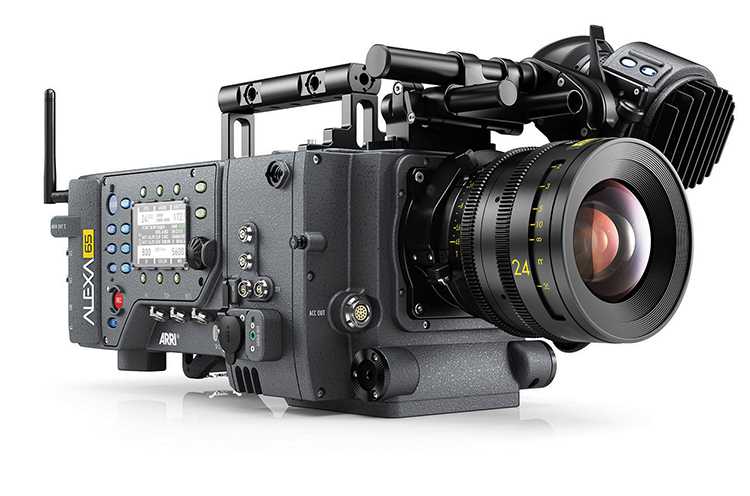
NEXT GEN CAMERA MEDIA
Posted on Feb 5, 2019 by Julian Mitchell
The new Samsung Portable SSD X5 with the NVMe interface has a throughput performance that the HDR capture world has been waiting for
You might remember that when we started looking at the Samsung T series of portable SSD drives, we foresaw that camera manufacturers would covet the transfer speed performance of the device. Also through our many previous cases studied, we found that content creators would even go so far as to reverse engineer their cameras to work with the drives.
Samsung portable drives are now seen as required camera capture media for the latest capture devices, from cutting-edge companies like Blackmagic Design and Z Cam. These are products that have recognised the highly desirable small and light form factor of the Samsung portable drives and married them with their new camera outputs.
 IMAGES The Samsung Portable SSD X5 easily partners data-hungry camera, the ARRI Alexa 65.
IMAGES The Samsung Portable SSD X5 easily partners data-hungry camera, the ARRI Alexa 65.
“What it really speeds up, is the actual data transfer”
The High End
Up is the only direction camera recorded data is going. We asked Thunderbolt interface and post-production expert, Gary Adcock, what the new Samsung Portable SSD X5 would bring to high-end acquisition.
“Today, the most data hungry cameras are the ARRI Alexa 65 and the Phantom high-speed 4K camera,” says Adcock. “Neither writes camera native data at more than about 500 MB/s. All camera native media types require less than this, RED is just over 295 MB/s in 8K and the Sony Venice camera is about the same in 6K.”
So, at those data speeds the Samsung Portable SSD X5 easily partners even the highest data-producing cameras, but history shows us that data amounts are always on the increase. For instance, the latest Fantastic Beasts film produced 800TB of camera rushes.
Adcock also recognises the abilities of the new Samsung Portable SSD X5 drive away from acquisition. “While getting
2 GB/s is tremendous, it’s still faster than most systems can even write at for now,” he explains. “What it really speeds up, is the actual data transfer.”
As CineLab discovered in our last issue, for transcoding requirements, the Samsung Portable SSD X5 is a superb solution. In CineLab’s case, it helped turn 4K 10-bit DPXs to ProRes HQ 444 files at 35fps – drop the resolution down and you get even higher numbers and all rendering on the same drive. This kind of performance equals – and maybe even betters – a professional desktop solution.

“The data rates are going up and this is a very cool piece of kit to be using.”
The New HDR World
As we mentioned, one of the most data hungry cameras is the ARRI Alexa 65 at around 30MB per frame. If you’re shooting at 24fps, you can see how the data numbers quickly stack up. Start shooting at higher frame rates and the numbers can double.
But now in the new deeper bit depth of the HDR capture world, frame sizes themselves are getting even bigger. This is where the new Samsung Portable SSD X5 could come into its own. The specs for the drive speak for themselves.
With the latest Thunderbolt 3 chip sets on your workstation, probably new products from the last 18 months, you are looking at data transfer speeds of over 2 GB/s with the new Samsung Portable SSD X5 using the NVMe interface. The Samsung Portable SSD X5’s read/write speeds of 2,800/2,300 MB/s are 5.2x/4.5x faster respectively than a portable SSD with SATA interface and 25.5x/20.9x faster than an external HDD.
Lee Danskin is the CTO of Escape Technology, a major pro video reseller in Soho, London. He can certainly see the potential for the Samsung Portable SSD X5 in high-end acquisition.
“If you’re shooting ProRes on a little ARRI or a little RED camera, for instance, using 4:2:2 and a lot of compression, then you could get a reasonable amount of footage on the Samsung Portable SSD X5 drive -everything you need including all the versions and takes from the shoot,” says Danskin. “But when you have everyone shooting 4K, 4:4:4 and trying to do more not less, then you have that headroom that the Samsung portable drive gives you. The trend is always for more data, not less.”
He adds: “If you could then maybe daisy chain the Samsung Portable SSD X5 drives and put together two, three or four drives together, you’d have a great solution for recording – imagine an 8TB solution using this form factor, it would be a solution with a massive punch. Even if you could put two Samsung Portable SSD X5 drives together at 5 GB/s, you would see real progress with files that feature higher HDR bit depths and everything else that is coming down the stream including 8K and beyond. The data rates are going up and this is a very cool piece of kit to be using.
“Also imagine configuring two Samsung Portable SSD X5 drives as a RAID – you would have got a lot of performance with increased capacity.”
The new Samsung Portable SSD X5 drives are a capture solution that camera manufacturers are keeping their eyes on.
It is the clever form factor of the Samsung portable drive that is attracting them. Add the fast data transfer speed, the capacity, the fact that it’s the size of a small smartphone and it weighs just 150g, and you have a drive that is designed for the media-recording future.
 IMAGE Samsung Portable SSD X5’s read/write speeds are faster than a portable SSD with SATA interface
IMAGE Samsung Portable SSD X5’s read/write speeds are faster than a portable SSD with SATA interface
For more information visit the Samsung website
ADVERTISEMENT FEATURE








